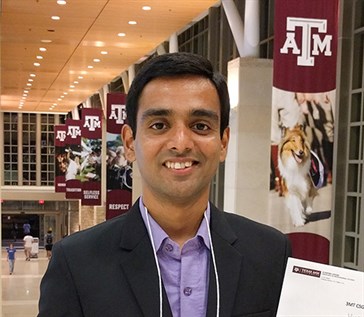
Vijay Rajanna, a doctoral student in the Department of Computer Science and Engineering at Texas A&M University recently participated in and received several awards for his presentation during the Three Minute Thesis (3MT) competition held on campus in November.
Rajanna received the first place and People’s Choice Award in the doctoral category; he was also selected as the Texas A&M representative at the 3MT regional competition to be held in Fayetteville, Arkansas, in February 2018 at the Conference of Southern Graduate Schools.
During the competition, graduate students have three minutes to present their thesis and its significance. This challenges students to consolidate their ideas and research discoveries to present concisely to an audience with no prior expertise. At Texas A&M, 3MT provides a high-impact learning experience for graduate students and is part of the Graduate and Resource Development (G.R.A.D.) for Aggies program.
At the competition, Rajanna presented the primary contributions of his doctoral research, which focuses on developing eye movement-based, multi-modal interactions for working on computers. These interactions are crucial in two scenarios – situational impairments, and impairments and disabilities by birth or due to an injury. He explained that in these two scenarios, a user wants to be able to perform at least a few basic operations conveniently on a computer.
“In this regard, we have developed a gaze and foot-based interaction framework to achieve accurate ‘point and click’ interactions on a computer,” Rajanna said. “Using this system, the user points the cursor at the desired target – a button – with their eye movements, and selects it by pressing a tiny sensor that is placed inside the shoe of the user. If the user does not have control over the foot, other methods like focusing on the target for 200 milliseconds or eye gestures can be used. With practice, users can point and click much faster than they do with the mouse. In addition, the same framework along with an enhanced virtual keyboard allows the user to enter text on a computer.”
Rajanna said that the 3MT competition is challenging, but is also highly rewarding. He currently works in the Sketch Recognition Lab under director Dr. Tracy Hammond, who is a professor in the department.
“I would like to thank my advisor Dr. Tracy Hammond and the members of the Sketch Recognition Lab who provided feedback on my written drafts and practice talks,” Rajanna said. “Also, I served as a graduate teaching fellow for two semesters, where I was mentored by Dr. John Keyser, Dr. Dilma Da Silva, Dr. Joseph Hurley, Dr. Aakash Tyagi and Dr. Vikram Kinra, who offered a significant learning experience.”
Rajanna’s ongoing research is centered on developing eye-movement based authentication methods to prevent shoulder surfing attacks, which occur in crowded places where it is easy to peer over another’s shoulder and steal potentially sensitive information, and achieving faster text entry in virtual reality using eye movements.